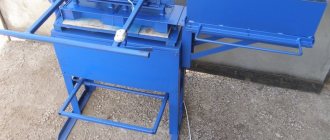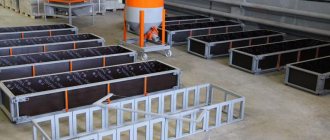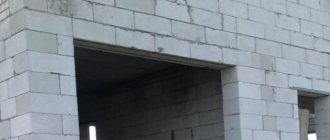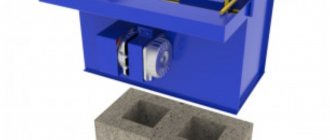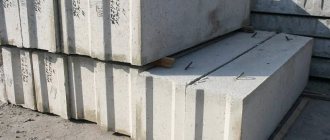The production process, which results in quality blocks, must meet all the necessary technical specifications when using special equipment.
What mechanisms and tools are required to create gas blocks can be found in this article.
Minimum set for making gas blocks
All aerated concrete blocks are made using autoclave and non-autoclave methods. In the first case, special drying cabinets are used, which are heated to a certain temperature.
They dry blocks in molds with periodic supply of hot steam. In the second case, the finished composition is distributed into molds and left to dry under normal atmospheric conditions until the aerated concrete is completely dry and clearly separated from the mold.
In order to make an aerated concrete block yourself, you need to prepare raw materials (a solution with components and hardening accelerators), as well as:
containers in the form of bunkers for mixing a special concrete composition with blowing agents and plasticizers;- component dispensers;
- vibrating sieve;
- concrete mixers or construction mixers;
- prefabricated forms for blocks;
- cutting complex;
- crushers.
In a mini-plant, they can also use:
- mortar mixing unit;
- small belt conveyors;
- nodes for automatic line control;
- forklift;
- hydraulic or conventional trolleys.
Finished products are placed in prepared places, covered with cellophane or on a stand made of wooden pallets. In a large enterprise, they are packaged in a special plastic wrapper and must be labeled.
At home, the master will need:
- container for mixing the solution;
- shovel;
- hand electric mixer;
- construction trowel (for filling and throwing mortar);
- tamping tool;
- prefabricated mold for given dimensions
- mobile tape with a complete set.
A mold for an aerated block can be purchased at a hardware store, but it can also be made in the form of a pencil case from high-quality wooden boards or plywood. Such a device should have jumpers and cuts that could then be easily removed from the resulting block.
The finished mixture is evenly unloaded into the mold and compacted until it is completely filled.
The generally accepted requirements for professional forms are the presence of two main parts: a pallet and sides , which can be easily removed and interchanged.
In factories, the pallet looks like a small metal cart on wheels, the base of which is made of moisture-resistant plywood or stainless steel.
Before pouring the prepared aerated concrete composition, the removable sides must be lubricated with a special agent.
How to equip a production workshop?
Set of equipment for the production of gas silicate blocks
The most important issue when organizing a business in this niche is the technological line for the production of gas silicate blocks. Suppliers offer a huge selection of equipment for sale today - from mini-devices to fully automated equipment. Therefore, when choosing machines for the production of gas silicate blocks, you need to take into account the following nuances:
- planned capacity of the enterprise,
- available starting capital.
The “middle” line for the production of gas silicate blocks includes the following machines and apparatus:
- Vibrating sieve - from 10,000 rubles.
- Dispensers - from 20,000 rubles.
- Mill - from 40,000 rubles.
- Concrete mixer - from 30,000 rubles.
- Industrial autoclave – from 200,000 rubles.
- Molds for blocks – from 20,000 rubles/piece.
In addition to the main equipment, the workshop cannot do without a loader, various mixing containers, and saws.
The final price of equipment for the production of gas silicate blocks depends primarily on the planned capacity. To start a small enterprise, 500,000 rubles may be enough. But when buying such a line, you don’t have to wait to receive large quantities of finished products - you have to start small. But if we talk about a large plant with huge capacities, it is impossible to do without impressive investments (up to 5,000,000 rubles). But for a “young” workshop, in order not to burn out even at the initial stages of business, it is better to purchase mini equipment for gas silicate.
It is a common practice when, in order to minimize the cost of equipping a workshop, equipment is brought from China or used machines are purchased.
Interesting articles:
Technology for the production of expanded clay concrete blocks.
What equipment to choose for polystyrene concrete blocks?
How to start your own business producing aerated concrete?
Criterias of choice
In order to choose the right equipment for the production of aerated concrete, it is necessary to determine the purpose of the product (long-term production or one-time use), as well as the amount of investment.
For one-time production, you can find advertisements on social networking sites offering equipment rental with a daily fee. If a person wants to make blocks with his own hands for his own construction needs, then this is a completely acceptable option.
If you want to start a business producing gas blocks, the minimum investment amount will be from 30,000 rubles (mobile belts). This is exactly how much a special mobile installation “Aerated Concrete-Master 230” now costs, which is quite suitable for home use.
If a person wants to seriously engage in the production of aerated concrete blocks on an ongoing basis, and he has the necessary capital for this, then a conveyor belt in a specially equipped room will be the best option, as it will perform all types of work with aerated concrete material at the highest level.
For the first time, you can purchase inexpensive Chinese machines . Then, if desired, it can be replaced with domestic, Finnish or German lines.
When choosing an equipment supplier, pay attention to their legality and availability of licensing documents. Manufacturers or suppliers must have certificates for all component mechanisms. Boxes with new mechanisms must be carefully packed, without damage, and have markings, instructions and a warranty card.
General technology for the production of aerated concrete
First, perhaps, let’s consider the general principle of the technological process. Indeed, for a full overview of the equipment lines, we need to have an idea of how exactly the aerated concrete block is made.
Necessary raw materials
To prepare an aerated concrete mixture, you will need the following raw materials:
- Cement grade no less than M400;
- Water;
- Quicklime;
- Gypsum;
- Quartz sand;
- Aluminum powder.
Aluminum powder
It also doesn’t hurt to add a plasticizer to the solution. Its main purpose is to increase the plasticity of the solution, which prevents cracking of products at the drying and hardening stage.
Plasticizer
Other chemical additives are also used. As a rule, they are added to improve the quality of finished products.
Proportions of raw materials with additives
Note! The above composition is classic. Many components can be replaced. In this case, the set of numeric property values will also vary.
- The siliceous component can be presented in the form of: sand, ash and other secondary industrial products;
- The type of binder can also be different: cement, slag, lime, mixed, ash.
The approximate content of the proportions is as follows:
- 50-60% - cement;
- 20-40% - sand;
- 1-10% - lime;
- Up to 1% - water.
On a note! If you want to increase the density of products, you should increase the amount of cement. In this case, the mass of the finished material and the thermal conductivity coefficient will also change.
Proportions depending on the desired density
Main stages
Brief instructions look like this:
- First of all, the components are weighed and mixed in the required proportions. When making it yourself, this is done manually, in a factory environment, usually in automatic mode.
- All ingredients go into the mixer, where mixing occurs.
- The next step will be molding. The molds are filled approximately 1/3 full, since when pores form, the mixture can simply leak out.
- Next, after completing the swelling process, wait some time until it partially hardens.
- Next, a single layer is cut or simply stripped if the forms are used in ready-made standard sizes.
- The last step will be autoclaving or sending the blocks for drying using a non-autoclave production method.
Note! The process may differ slightly depending on what equipment is used for the production of aerated concrete blocks. However, in general, the general principle will be the same.
Prices for different types of installations
The production of aerated concrete blocks using special equipment in the Russian Federation is considered at an average value. Often companies that produce and sell mechanisms and improvised means indicate the cost range in price lists on their official websites. The approximate cost for 2022 can be presented in the following table:
| Types of equipment for the production of gas blocks | Average price in the Russian Federation for 1 piece. |
| Component dispenser | 44 000 |
| Vibrating sieve | 26 500 |
| Containers in the form of bunkers | 90 000 |
| Concrete mixer | 13 800 |
| Construction mixer | 23 600 |
| Prefabricated mold for blocks | 18 500 |
| Hardening accelerator (1 kg) | 620 |
| Cutting complex | 520 400 |
| Crusher | 15 000 |
| Mortar mixing unit | 190 000 |
| Forklift | 554 000 |
| Pallet truck | 14 520 |
| Belt conveyors (line) | 217 410 |
| Shovel | 1 005 |
| Trowel | 500 |
| DIY kneading container | 4 000 |
| Automatic nodes for line control | 4 242 |
| Hand Tamping Tool | 3 000 |
| Pallets | 8 533 |
| Mobile station | 319 000 |
| Mold lubricant (1l) | 89 |
| Autoclave | 100 000 |
In each region, the cost of mechanisms and devices may vary by 15-20%. The most expensive equipment will be for cities such as Moscow, St. Petersburg and Novosibirsk.
Staff
Not only the area of the required premises and the volume of raw materials, but also the number of jobs depends on production volumes. With minimal volumes, you can do without hiring workers; the entrepreneur himself can handle this, but if you want production on a larger scale, you cannot do without hiring personnel (from 2 to 10 workers). You should think about a two-shift working day. As for wages, it is equal to 100-200 rubles per 1 cubic meter. m of manufactured products. This is somewhere around 20-30 thousand rubles. per month.
Equipment used
Regardless of the method of manufacturing gas silicate blocks, their production requires special equipment. All components are mixed in a mixer to obtain a homogeneous mixture of the desired consistency.
After preparing the solution, it is poured into molds that have removable formwork, and after they harden, cutting equipment is used to cut blocks of given sizes.
If an autoclave is used, the blocks are placed in it and kept for a certain time at high temperature and high pressure. If an autoclave is not used during the production process, they are sent for packaging.
Blocks can be manufactured with or without tongue-and-groove engagement. The use of tongue-and-groove blocks makes it possible to increase the thermal insulation characteristics of the house and obtain a stronger connection between them, so the strength of the building increases.
